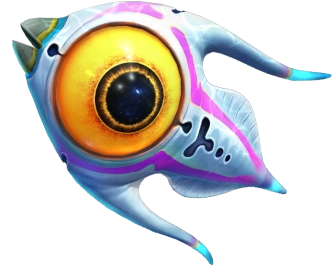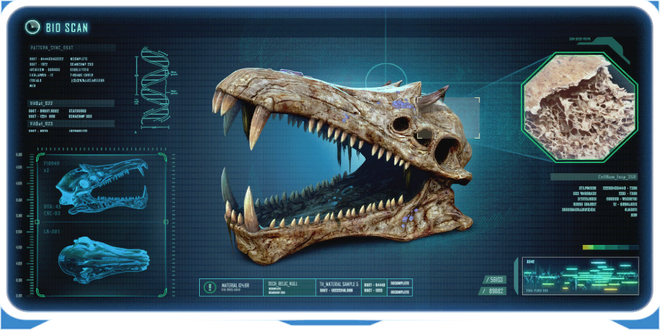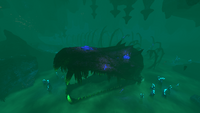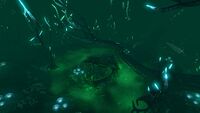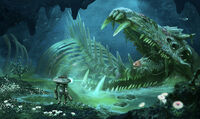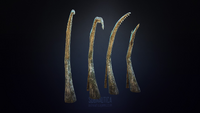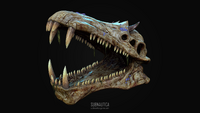
|
Read at own risk This article contains unmarked spoilers. Players new to the game would want to avoid or be cautious toward this article. |
The Gargantuan Fossil is an enormous and ancient fossil, approximately three million years old, found in the Bone Fields. The skeleton belonged to an eel-like, Leviathan Class super-predator dwarfing both the Sea Dragon Leviathan and Sea Emperor Leviathan, despite only being around one third of the whole skeleton. The remains consist of a huge, reptillian-esque skull and sixteen pairs of huge ribs. The skeleton is covered in flora and coral. The skull is so large that a Cyclops can fit inside its jaws. Smaller versions of its ribs can be seen in the entrance to the Lost River Junction. There is also a smaller variant of this creature's skull which can be found in the Ghost Forest.
The Precursors were also studying these remains, as evidenced by small, angular indentations on the ribcage. These samples were probably studied at the Lost River Laboratory Cache, as this was the main site in which Leviathan class bone samples are found.
Resting Place
How it came to rest in the Lost River is difficult to explain. Though due to the mostly intact nature of the bones still left, it is likely that at some point in the last three million years since it died, a major fault occurred in the seabed due to volcanic activity and the area with the front third of the skeleton on descended hundreds of metres down into the ground whilst the other two thirds of it have likely been buried closer to the surface. The skeleton was most likely buried and then uncovered by the formation of the Lost River cave system. The second, smaller skull in the Ghost Forest most likely belongs to a juvenile of the species and may have come to rest there by similar means. A small section of a rib cage belonging to this species can also be found close to the Bones Field, likely belonging to another juvenile.
Size
The skeleton is enormous. The skull by itself is just under 100 metres in length, almost as long as the entire body of a Sea Dragon Leviathan. The two lower front teeth measure at 11.4 metres in height and the two upper teeth at 10.3 metres. The large, rear eye sockets measure 9.7 metres in diameter.
The skeleton that remains measures at 402 metres in length, and with the PDA estimating that it is only one third of the complete specimen, the creature would have measured between 1100 and 1300 metres long.
In Life
When this creature still roamed the planet, the sheer size of its body (1.2km) would have prevented it from living within the crater, as it is more than half the diameter of the crater (2km).
The size of the creature would have restricted it to live almost entirely in the areas off the edge of the crater as an adult, most likely feeding off of planktivorous Leviathans that also inhabited this area such as the Ghost Leviathan and possibly the Sea Emperor Leviathan as well as a myriad of species that are likely extinct since that period.
They were likely very long-lived and with extremely low reproductive rates as a large population of these creatures would very quickly destroy the entire ecosystem due to the massive amount of food required to fuel such a large predator.
The reptilian skull may suggest distant relation to the Sea Dragon and, by extension the Sea Emperor, possibly belonging to the same order. Though these similarities may be purely superficial. It is also possible that rather than the rib cage having toppled over into an upside-down state, the rib cage is in fact the correct way up and this creature had a similar skeletal structure to the Sea Dragon, and shared its unusual upside-down rib cage
